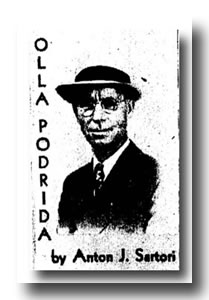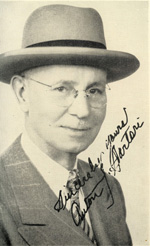Memorial Tribute
Anton J. Sartori Jr 1883-1958
LeMars Globe-Post
September 29, 1958
As a memorial to the late Anton J. Sartori, The Globe-Post here with reprints an article written by Lauretta Kass Traufler and published in the Sioux City Journal, Nov. 21, 1954:
By Lauretta Kass Traufler
For 27 years Anton J. Sartori, former LeMars druggist, has lived in California, but his most cherished and treasured memories are of his boyhood days spent in a small Iowa town.
He has written a book, recently published, in which he recalls with nostalgic affection and humor the colorful personalities and stirring events of those early days, the 80’s and 90’s, when as a carefree lad he lived above his father’s drug store.
The book is a journey through memory lanes, through those tranquil and peaceful days—pre war and pre automobile. It is an historical review of the period with personal reminiscences which reflect the color and atmosphere of the time when Iowa herself was young.
It is a collection of articles which Mr. Sartori has written during the last 17 years, which, exhilarating and wonderful, have been published in the LeMars Globe-Post in his column titled, Olla Podrida. The title, Mr. Sartori explained, is a Spanish expression for a mixture, a hodgepodge, a stew made of many ingredients some fresh, some leftovers brought to a state of piquancy with added seasoning and spice. He titled his book, Morsels From Olla Podrida.
Mr. Sartori did not call those early days “the good old days” or “the golden age.” The pleasures of those days may seem dull and unexciting today, but for the young lad those days were full of enchantment and adventure.
PASSION OF YOUTH
“There were hunting and trapping to be done in the winter, skating on the old mill pond, and long merry sleigh rides with the sleigh bells tinkling. There was fishing and swimming in the summer, and caves to be built in the prairies and in the forests, for much of the land was untamed and unclaimed. There was the excitement of watching the trains come in at the depot and of visiting Corkey’s livery stable where sometimes there were as many as 40 horses which sometimes even you were allowed to currycomb.
“And there was that heady, grown-up feeling you got when you joined with the others in the livery stable in deciding and ridiculing those who had returned from Chicago talking about a horseless carriage, a buggy that was said to run by itself.
“How could a buggy run by itself we thought as we proudly rode to church in our new fringed surrey with old broadbacked Babe in the shafts? The idea seemed so silly. I laughed outright. But the next day when I told Mr. Corkey about it, he shook his head gravely and didn’t smile at all but just went on currying the horses.”
Later how these rumors became a reality is told in his book:
“As I recall, the first automobile driving on the streets of the old home town of LeMars was a horseless carriage shipped to towns of the Midwest during the late 90s by a Chicago mail order house as an advertising stunt.”
COMES THE “HORSELESS”
“The highly publicized day arrived locals to the number of several hundred gathering near the passenger depot where a special railway car had been set out on a siding. Inside this railway car was the buggy that was said to run by itself.
“Experts sent out by the mail order house wheeled the contraption out of the car and down a ramp to the ground. Almost before the dust had settled, two very serious looking men climbed up onto the seat and directly the gosh-darned thing started moving.
“As the crowd made way for this unearthly thing, several youthful daredevils and I among them, rushed forward bent on hooking a ride. Brushed off, we stood open-mouthed like the others in the crowd while the new-fangled vehicle shot westward at breakneck speed, up the dirt road now known as First street NE.
“Watching spellbound as we viewed the demonstration that day, we little dreamed we were doing our small part in welcoming advent of a new era, and that what we then looked upon with awe would shortly become commonplace.
“The cars were considered a menace to owners of horse drawn vehicles and sometimes even pedestrians were half scared out of their wits.”
FIRST AT REMSEN
“Among those who pioneered as automobile owners were Dr. W.M. Richey, who in 1903 owned a Pope Toledo, costing the tidy sum of $4,500 and guaranteed to do a mile a minute. C. L. Trenery, Misses Alice and Sybil Moore, George Tangeman, George Kluckhohn, Dr. C. H. Mammen and Charles von Berg, Rev. F.X. Schulte was the first to drive a motor powered vehicle on the streets of Remsen. That was in 1903. Driving a steam-propelled car, von Berg won the first automobile race ever held in this area.”
Writing in another vein in another column Mr. Sartori told of his mother and her religious faith.
“Mother took religion in tremendous doses. And she believed for all she was worth in the efficiency of prayer. Furthermore, she was best able of anyone I have ever known defending the faith that was in her.
“I have found in later life that she was right—Prayer, accompanied by hard work, will work wonders. It has been a long time now, but I used to enjoy teasing my mother with some piece of impudence because of her unshakable belief in the power of prayer to produce effects. As the years pile up and I look back on some of the things I have seen with my own eyes, I am often sorry I ever made such brash statements, even in fun. Prayer has seemingly done the trick too many times.”
(This column was declared by John M. Henry, secretary of the Press Columnists of Iowa, to be one of Iowa’s best.)
Mr. Sartori began writing his column in the LeMars Globe-Post after his first return to LeMars for a visit 17 years ago. Writing, however, is his avocation, not his vocation.
HE’S A BANKER NOW…..
Moving to California in 1927, because of slackness in the drug store business during the Depression, he became associated in the banking business with his uncle, the late J. F. Sartori, president of the First Security National bank of Los Angeles. The elder Sartori, like many men who have been exceptionally successful in life, was a firm believer in hard work and in showing no favoritism, not even to relatives.
At the bank and its numerous branches where Tony worked he was know as J. Anthon so the Sartori name would not bring him a show of favoritism.
He started as receiving clerk, hand trucking supplies, such as paper, envelopes and banking forms used in the bank. From this he was graduated to purchasing agent. Today he is a successful officer of the bank serving many departments.
The California press refers to Anton Sartori as “Iowa’s Ambassador to California.” In an unofficial way he is just that. He secures many new depositors for the bank when Iowans move there.
Anton Sartori has assisted thousands of Iowans to find jobs in California, find homes and apartments, locate friends, avoid financial or real estate pitfalls or just to plan California vacations. He carries on a voluminous correspondence with former Iowans living in various parts of California. His column is filled with news of these former Iowans. But his “ambassadorship” and his writing are both hobbies and he does not seek to commercialize them. He recently sent more than 800 autographed copies of his book as gifts to Iowans living in California.




